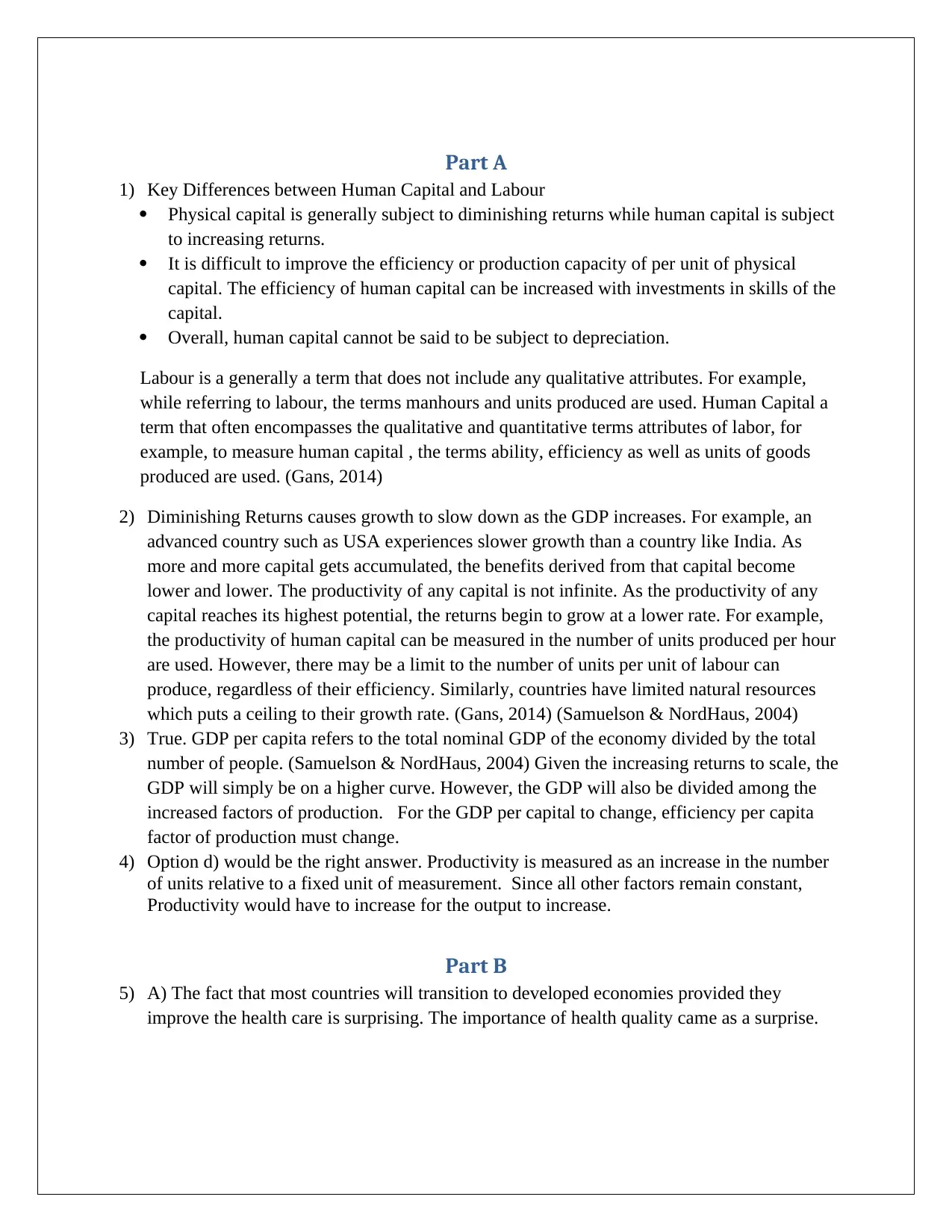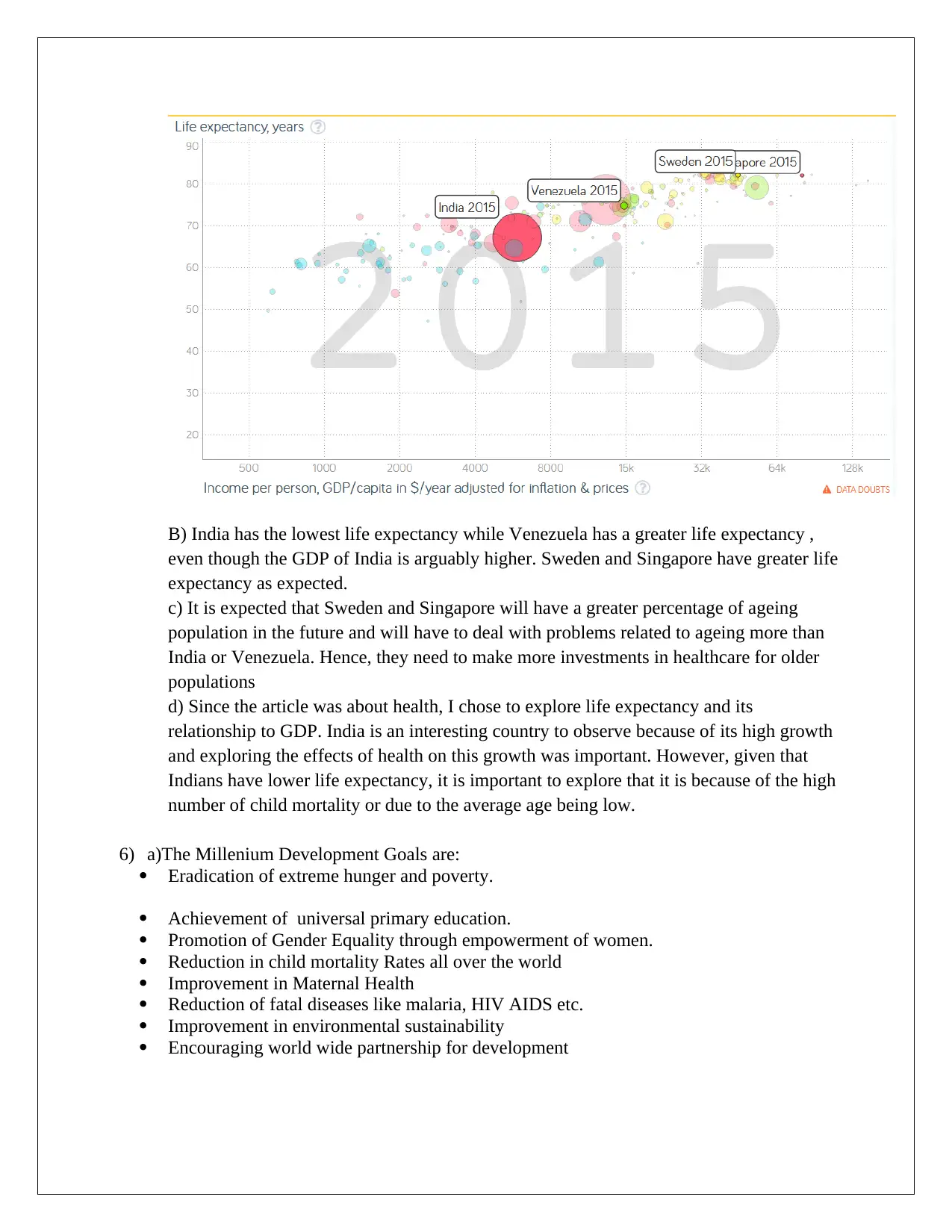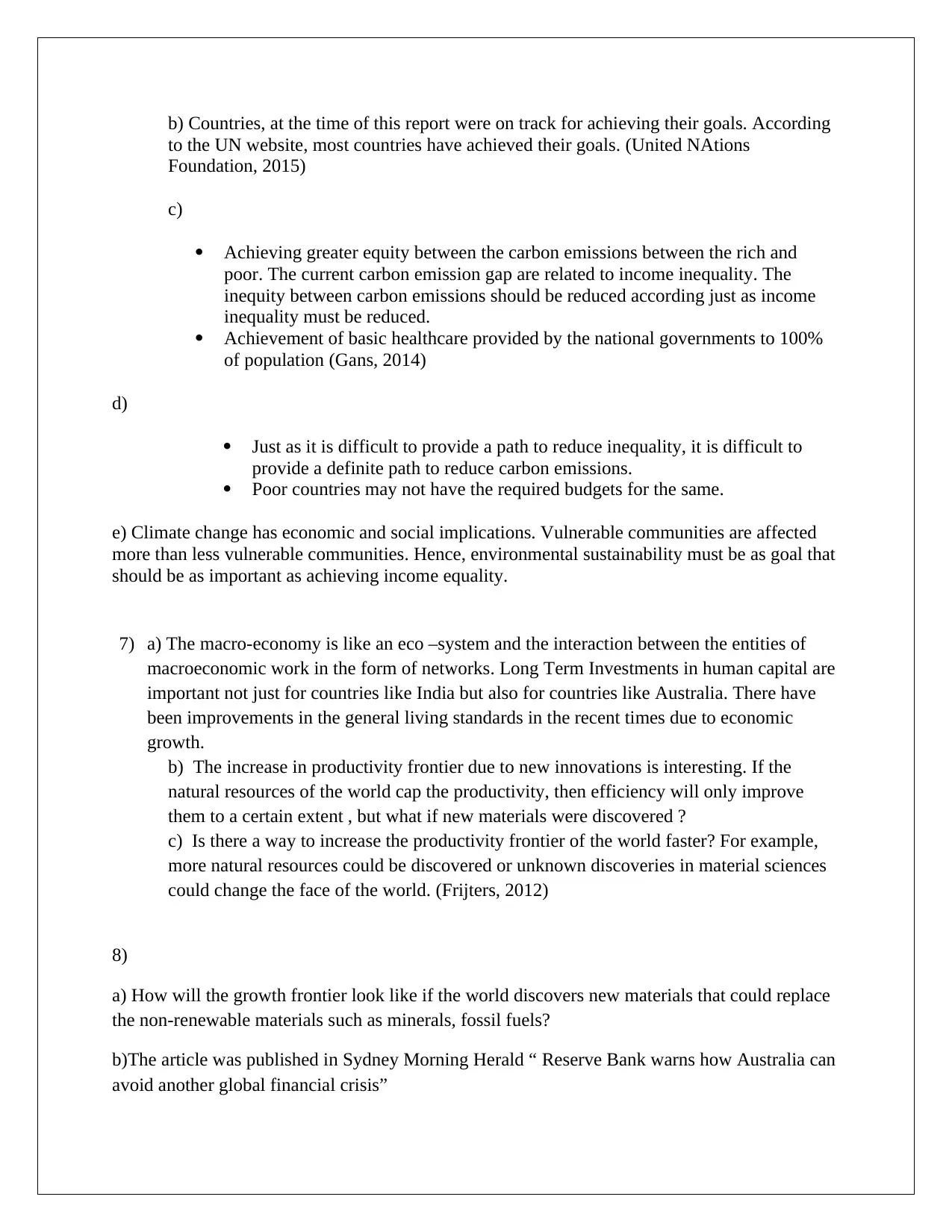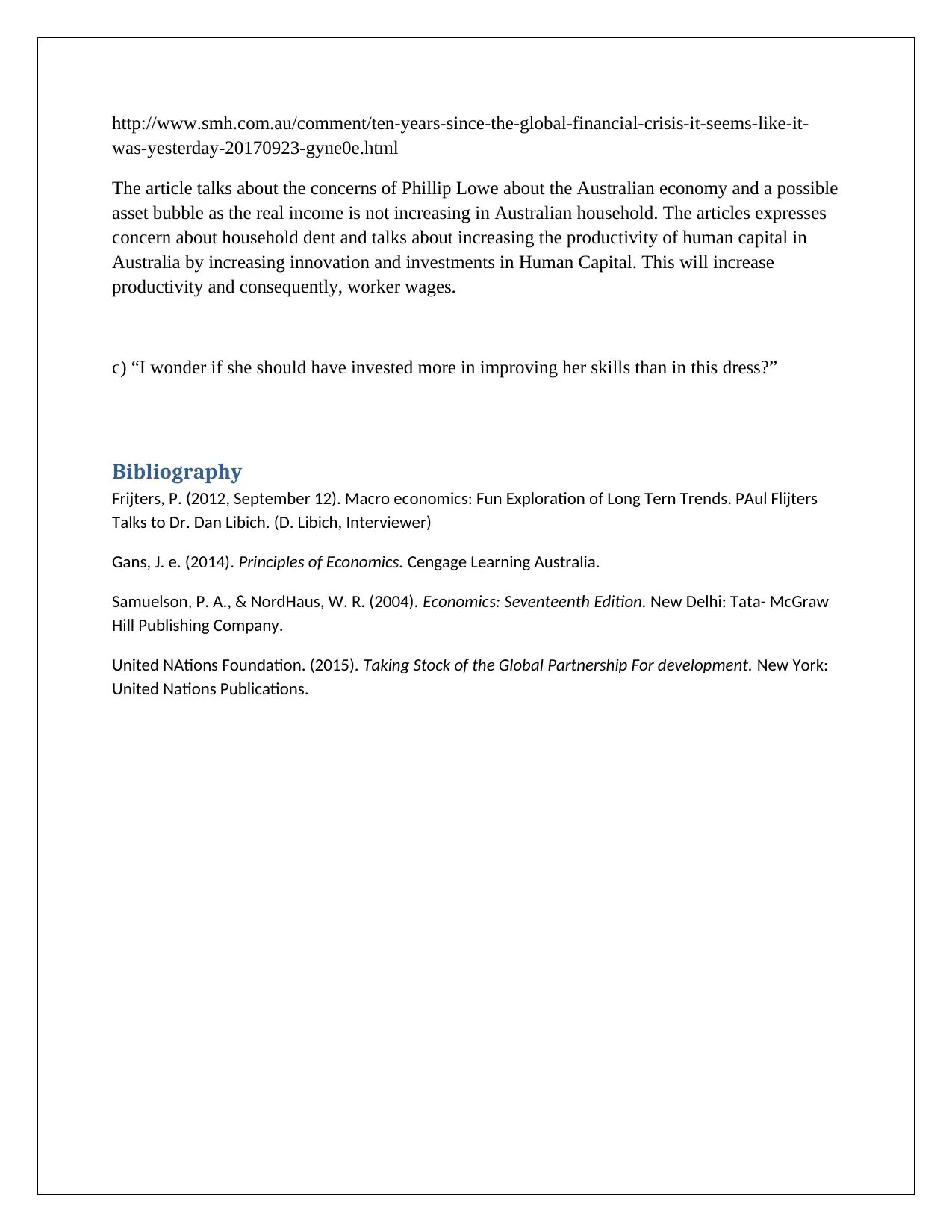BUS5POE Problem Set 9: Macroeconomic Analysis and Health Impacts
VerifiedAdded on 2020/03/16
|6
|1283
|55
Homework Assignment
AI Summary
This economics assignment, focusing on macroeconomic principles and economic development, analyzes the key differences between human and physical capital, exploring the concept of diminishing returns and its impact on economic growth. It examines the relationship between GDP per capita and factors of production, and investigates the surprising importance of healthcare quality in developing economies. The assignment also delves into the Millennium Development Goals, carbon emissions, and the productivity frontier, alongside an analysis of an article discussing the Australian economy and the importance of human capital and innovation for economic stability. The assignment also includes a bibliography of the sources used.

qwertyuiopasdfghjklzxcvbnmqwertyui
opasdfghjklzxcvbnmqwertyuiopasdfgh
jklzxcvbnmqwertyuiopasdfghjklzxcvb
nmqwertyuiopasdfghjklzxcvbnmqwer
tyuiopasdfghjklzxcvbnmqwertyuiopas
dfghjklzxcvbnmqwertyuiopasdfghjklzx
cvbnmqwertyuiopasdfghjklzxcvbnmq
wertyuiopasdfghjklzxcvbnmqwertyuio
pasdfghjklzxcvbnmqwertyuiopasdfghj
klzxcvbnmqwertyuiopasdfghjklzxcvbn
mqwertyuiopasdfghjklzxcvbnmqwerty
uiopasdfghjklzxcvbnmqwertyuiopasdf
ghjklzxcvbnmqwertyuiopasdfghjklzxc
vbnmqwertyuiopasdfghjklzxcvbnmrty
uiopasdfghjklzxcvbnmqwertyuiopasdf
ghjklzxcvbnmqwertyuiopasdfghjklzxc
BUS5POE PROBLEM SET No 9
[Pick the date]
Com
opasdfghjklzxcvbnmqwertyuiopasdfgh
jklzxcvbnmqwertyuiopasdfghjklzxcvb
nmqwertyuiopasdfghjklzxcvbnmqwer
tyuiopasdfghjklzxcvbnmqwertyuiopas
dfghjklzxcvbnmqwertyuiopasdfghjklzx
cvbnmqwertyuiopasdfghjklzxcvbnmq
wertyuiopasdfghjklzxcvbnmqwertyuio
pasdfghjklzxcvbnmqwertyuiopasdfghj
klzxcvbnmqwertyuiopasdfghjklzxcvbn
mqwertyuiopasdfghjklzxcvbnmqwerty
uiopasdfghjklzxcvbnmqwertyuiopasdf
ghjklzxcvbnmqwertyuiopasdfghjklzxc
vbnmqwertyuiopasdfghjklzxcvbnmrty
uiopasdfghjklzxcvbnmqwertyuiopasdf
ghjklzxcvbnmqwertyuiopasdfghjklzxc
BUS5POE PROBLEM SET No 9
[Pick the date]
Com
Paraphrase This Document
Need a fresh take? Get an instant paraphrase of this document with our AI Paraphraser

Contents
Part A...........................................................................................................................................................3
Part B...........................................................................................................................................................3
Bibliography................................................................................................................................................6
Part A...........................................................................................................................................................3
Part B...........................................................................................................................................................3
Bibliography................................................................................................................................................6

Part A
1) Key Differences between Human Capital and Labour
Physical capital is generally subject to diminishing returns while human capital is subject
to increasing returns.
It is difficult to improve the efficiency or production capacity of per unit of physical
capital. The efficiency of human capital can be increased with investments in skills of the
capital.
Overall, human capital cannot be said to be subject to depreciation.
Labour is a generally a term that does not include any qualitative attributes. For example,
while referring to labour, the terms manhours and units produced are used. Human Capital a
term that often encompasses the qualitative and quantitative terms attributes of labor, for
example, to measure human capital , the terms ability, efficiency as well as units of goods
produced are used. (Gans, 2014)
2) Diminishing Returns causes growth to slow down as the GDP increases. For example, an
advanced country such as USA experiences slower growth than a country like India. As
more and more capital gets accumulated, the benefits derived from that capital become
lower and lower. The productivity of any capital is not infinite. As the productivity of any
capital reaches its highest potential, the returns begin to grow at a lower rate. For example,
the productivity of human capital can be measured in the number of units produced per hour
are used. However, there may be a limit to the number of units per unit of labour can
produce, regardless of their efficiency. Similarly, countries have limited natural resources
which puts a ceiling to their growth rate. (Gans, 2014) (Samuelson & NordHaus, 2004)
3) True. GDP per capita refers to the total nominal GDP of the economy divided by the total
number of people. (Samuelson & NordHaus, 2004) Given the increasing returns to scale, the
GDP will simply be on a higher curve. However, the GDP will also be divided among the
increased factors of production. For the GDP per capital to change, efficiency per capita
factor of production must change.
4) Option d) would be the right answer. Productivity is measured as an increase in the number
of units relative to a fixed unit of measurement. Since all other factors remain constant,
Productivity would have to increase for the output to increase.
Part B
5) A) The fact that most countries will transition to developed economies provided they
improve the health care is surprising. The importance of health quality came as a surprise.
1) Key Differences between Human Capital and Labour
Physical capital is generally subject to diminishing returns while human capital is subject
to increasing returns.
It is difficult to improve the efficiency or production capacity of per unit of physical
capital. The efficiency of human capital can be increased with investments in skills of the
capital.
Overall, human capital cannot be said to be subject to depreciation.
Labour is a generally a term that does not include any qualitative attributes. For example,
while referring to labour, the terms manhours and units produced are used. Human Capital a
term that often encompasses the qualitative and quantitative terms attributes of labor, for
example, to measure human capital , the terms ability, efficiency as well as units of goods
produced are used. (Gans, 2014)
2) Diminishing Returns causes growth to slow down as the GDP increases. For example, an
advanced country such as USA experiences slower growth than a country like India. As
more and more capital gets accumulated, the benefits derived from that capital become
lower and lower. The productivity of any capital is not infinite. As the productivity of any
capital reaches its highest potential, the returns begin to grow at a lower rate. For example,
the productivity of human capital can be measured in the number of units produced per hour
are used. However, there may be a limit to the number of units per unit of labour can
produce, regardless of their efficiency. Similarly, countries have limited natural resources
which puts a ceiling to their growth rate. (Gans, 2014) (Samuelson & NordHaus, 2004)
3) True. GDP per capita refers to the total nominal GDP of the economy divided by the total
number of people. (Samuelson & NordHaus, 2004) Given the increasing returns to scale, the
GDP will simply be on a higher curve. However, the GDP will also be divided among the
increased factors of production. For the GDP per capital to change, efficiency per capita
factor of production must change.
4) Option d) would be the right answer. Productivity is measured as an increase in the number
of units relative to a fixed unit of measurement. Since all other factors remain constant,
Productivity would have to increase for the output to increase.
Part B
5) A) The fact that most countries will transition to developed economies provided they
improve the health care is surprising. The importance of health quality came as a surprise.
⊘ This is a preview!⊘
Do you want full access?
Subscribe today to unlock all pages.

Trusted by 1+ million students worldwide

B) India has the lowest life expectancy while Venezuela has a greater life expectancy ,
even though the GDP of India is arguably higher. Sweden and Singapore have greater life
expectancy as expected.
c) It is expected that Sweden and Singapore will have a greater percentage of ageing
population in the future and will have to deal with problems related to ageing more than
India or Venezuela. Hence, they need to make more investments in healthcare for older
populations
d) Since the article was about health, I chose to explore life expectancy and its
relationship to GDP. India is an interesting country to observe because of its high growth
and exploring the effects of health on this growth was important. However, given that
Indians have lower life expectancy, it is important to explore that it is because of the high
number of child mortality or due to the average age being low.
6) a)The Millenium Development Goals are:
Eradication of extreme hunger and poverty.
Achievement of universal primary education.
Promotion of Gender Equality through empowerment of women.
Reduction in child mortality Rates all over the world
Improvement in Maternal Health
Reduction of fatal diseases like malaria, HIV AIDS etc.
Improvement in environmental sustainability
Encouraging world wide partnership for development
even though the GDP of India is arguably higher. Sweden and Singapore have greater life
expectancy as expected.
c) It is expected that Sweden and Singapore will have a greater percentage of ageing
population in the future and will have to deal with problems related to ageing more than
India or Venezuela. Hence, they need to make more investments in healthcare for older
populations
d) Since the article was about health, I chose to explore life expectancy and its
relationship to GDP. India is an interesting country to observe because of its high growth
and exploring the effects of health on this growth was important. However, given that
Indians have lower life expectancy, it is important to explore that it is because of the high
number of child mortality or due to the average age being low.
6) a)The Millenium Development Goals are:
Eradication of extreme hunger and poverty.
Achievement of universal primary education.
Promotion of Gender Equality through empowerment of women.
Reduction in child mortality Rates all over the world
Improvement in Maternal Health
Reduction of fatal diseases like malaria, HIV AIDS etc.
Improvement in environmental sustainability
Encouraging world wide partnership for development
Paraphrase This Document
Need a fresh take? Get an instant paraphrase of this document with our AI Paraphraser

b) Countries, at the time of this report were on track for achieving their goals. According
to the UN website, most countries have achieved their goals. (United NAtions
Foundation, 2015)
c)
Achieving greater equity between the carbon emissions between the rich and
poor. The current carbon emission gap are related to income inequality. The
inequity between carbon emissions should be reduced according just as income
inequality must be reduced.
Achievement of basic healthcare provided by the national governments to 100%
of population (Gans, 2014)
d)
Just as it is difficult to provide a path to reduce inequality, it is difficult to
provide a definite path to reduce carbon emissions.
Poor countries may not have the required budgets for the same.
e) Climate change has economic and social implications. Vulnerable communities are affected
more than less vulnerable communities. Hence, environmental sustainability must be as goal that
should be as important as achieving income equality.
7) a) The macro-economy is like an eco –system and the interaction between the entities of
macroeconomic work in the form of networks. Long Term Investments in human capital are
important not just for countries like India but also for countries like Australia. There have
been improvements in the general living standards in the recent times due to economic
growth.
b) The increase in productivity frontier due to new innovations is interesting. If the
natural resources of the world cap the productivity, then efficiency will only improve
them to a certain extent , but what if new materials were discovered ?
c) Is there a way to increase the productivity frontier of the world faster? For example,
more natural resources could be discovered or unknown discoveries in material sciences
could change the face of the world. (Frijters, 2012)
8)
a) How will the growth frontier look like if the world discovers new materials that could replace
the non-renewable materials such as minerals, fossil fuels?
b)The article was published in Sydney Morning Herald “ Reserve Bank warns how Australia can
avoid another global financial crisis”
to the UN website, most countries have achieved their goals. (United NAtions
Foundation, 2015)
c)
Achieving greater equity between the carbon emissions between the rich and
poor. The current carbon emission gap are related to income inequality. The
inequity between carbon emissions should be reduced according just as income
inequality must be reduced.
Achievement of basic healthcare provided by the national governments to 100%
of population (Gans, 2014)
d)
Just as it is difficult to provide a path to reduce inequality, it is difficult to
provide a definite path to reduce carbon emissions.
Poor countries may not have the required budgets for the same.
e) Climate change has economic and social implications. Vulnerable communities are affected
more than less vulnerable communities. Hence, environmental sustainability must be as goal that
should be as important as achieving income equality.
7) a) The macro-economy is like an eco –system and the interaction between the entities of
macroeconomic work in the form of networks. Long Term Investments in human capital are
important not just for countries like India but also for countries like Australia. There have
been improvements in the general living standards in the recent times due to economic
growth.
b) The increase in productivity frontier due to new innovations is interesting. If the
natural resources of the world cap the productivity, then efficiency will only improve
them to a certain extent , but what if new materials were discovered ?
c) Is there a way to increase the productivity frontier of the world faster? For example,
more natural resources could be discovered or unknown discoveries in material sciences
could change the face of the world. (Frijters, 2012)
8)
a) How will the growth frontier look like if the world discovers new materials that could replace
the non-renewable materials such as minerals, fossil fuels?
b)The article was published in Sydney Morning Herald “ Reserve Bank warns how Australia can
avoid another global financial crisis”

http://www.smh.com.au/comment/ten-years-since-the-global-financial-crisis-it-seems-like-it-
was-yesterday-20170923-gyne0e.html
The article talks about the concerns of Phillip Lowe about the Australian economy and a possible
asset bubble as the real income is not increasing in Australian household. The articles expresses
concern about household dent and talks about increasing the productivity of human capital in
Australia by increasing innovation and investments in Human Capital. This will increase
productivity and consequently, worker wages.
c) “I wonder if she should have invested more in improving her skills than in this dress?”
Bibliography
Frijters, P. (2012, September 12). Macro economics: Fun Exploration of Long Tern Trends. PAul Flijters
Talks to Dr. Dan Libich. (D. Libich, Interviewer)
Gans, J. e. (2014). Principles of Economics. Cengage Learning Australia.
Samuelson, P. A., & NordHaus, W. R. (2004). Economics: Seventeenth Edition. New Delhi: Tata- McGraw
Hill Publishing Company.
United NAtions Foundation. (2015). Taking Stock of the Global Partnership For development. New York:
United Nations Publications.
was-yesterday-20170923-gyne0e.html
The article talks about the concerns of Phillip Lowe about the Australian economy and a possible
asset bubble as the real income is not increasing in Australian household. The articles expresses
concern about household dent and talks about increasing the productivity of human capital in
Australia by increasing innovation and investments in Human Capital. This will increase
productivity and consequently, worker wages.
c) “I wonder if she should have invested more in improving her skills than in this dress?”
Bibliography
Frijters, P. (2012, September 12). Macro economics: Fun Exploration of Long Tern Trends. PAul Flijters
Talks to Dr. Dan Libich. (D. Libich, Interviewer)
Gans, J. e. (2014). Principles of Economics. Cengage Learning Australia.
Samuelson, P. A., & NordHaus, W. R. (2004). Economics: Seventeenth Edition. New Delhi: Tata- McGraw
Hill Publishing Company.
United NAtions Foundation. (2015). Taking Stock of the Global Partnership For development. New York:
United Nations Publications.
⊘ This is a preview!⊘
Do you want full access?
Subscribe today to unlock all pages.

Trusted by 1+ million students worldwide
1 out of 6
Related Documents
Your All-in-One AI-Powered Toolkit for Academic Success.
+13062052269
info@desklib.com
Available 24*7 on WhatsApp / Email
![[object Object]](/_next/static/media/star-bottom.7253800d.svg)
Unlock your academic potential
Copyright © 2020–2025 A2Z Services. All Rights Reserved. Developed and managed by ZUCOL.





